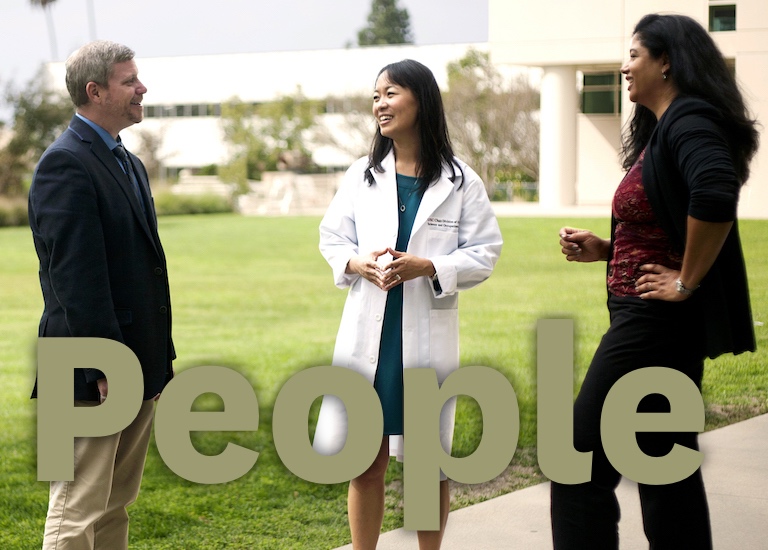Student Blog
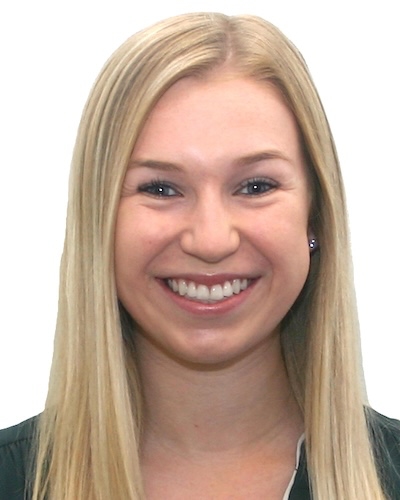
My SChedule ⟩
November 17, 2018, by Jessica P.
Classes Fieldwork School/Life Balance
As an ambassador, one of the most common questions I get from prospective students is “what does your typical schedule look like?” Along with this, people ask if there’s time to work, time for self-care, and balance in your weekly schedule. My fellow ambassadors, Joyce and Evan, recently discussed working and having a baby in grad school. From my personal experience, I think it all has to do with balance.
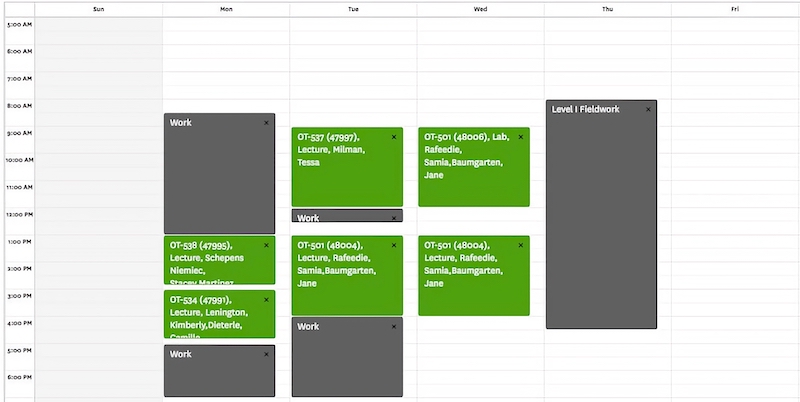
My Fall 2018 schedule
Throughout the program, it is typical to be in the classroom 3 days a week, 1 day in fieldwork, and 1 day off. For the days that we’re in the classroom, it is normal to have class 9am-12pm, a lunch break 12pm-1pm, and then class again from 1pm-4pm. For many people, like myself, a three-hour class may sound daunting, but it’s not. Luckily, all of our professors give us breaks with plenty of time to grab coffee, snacks, or simply take a quick walk outside to get some fresh air. Most of our classes utilize team-based learning, meaning that we usually are not getting a lecture for the entire class time. For example, in my Adult Physical Rehabilitation course we spend class time doing hands-on case applications where we apply what we have already studied on our own.
Everyone’s fieldwork hours will be slightly different, as you will follow whatever hours your clinical instructor works. The hours occupational therapists work may look different in the various settings. For example, my pediatrics level I fieldwork was 10am-6pm as many of our pediatric clients were coming after school. This semester, I just finished my last level I fieldwork at an outpatient lymphedema clinic where my hours were 8am-4:30pm.
As a student ambassador, I have the privilege to work 10 hours a week for the division doing various tasks and events. I have found working 10 hours per week is manageable, but it is something I have to plan for. I know that I have weekly quizzes on Tuesday, so on Sunday’s I study for my quizzes instead of cramming late on Monday night. Many of my classmates also work around 10 hours, doing other student worker positions at USC, such as being classroom assistants or research assistants. We probably would all agree that working that amount is doable, but anything more than that could be stressful on top of your coursework.
One of my favorite days though is my day off. While I love being in the classroom and at fieldwork, I depend on my day off to recharge and prepare for the upcoming week ahead. By having a day off, I think it really allows us to have a balanced schedule with time to have doctor’s appointments, work, catch up readings, etc.
Throughout grad school, there will definitely be weeks where it can feel overwhelming. My best advice is to listen to your own body and what balance looks like for you. You may need a full 8 hours of sleep while some of your classmates seem to fully function off of only 5 hours, but always listen to what is best for you. Transitioning to grad school is definitely a transition into a new role in life, but once you get a hang of the schedule and what works for you — you will own it!
⋯
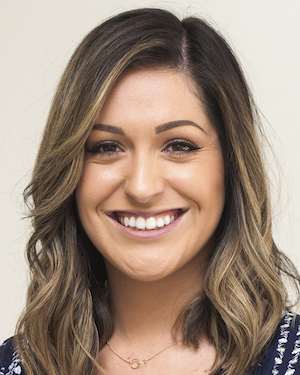
Financing USC: What You Need to Know ⟩
November 16, 2018, by Melissa
As we’ve gotten closer to the application deadline, one of the questions I’ve gotten the most concerns paying for USC and whether the “financial burden” is worth it. Thus, I wanted to take the time to give you guys some insight as to what my thought process looked like when I was applying, and why I feel like coming to USC was the best decision I’ve ever made.
First of all, I want to validate your concerns and let you know that it is completely normal to be intimidated by the cost of tuition at our program. It is more expensive than most programs, and it may feel like a lot to take on. However, I think it’s important that you know what your financing options are before you make a decision. I will admit that to me, it was a bit of a no-brainer. Despite the fact that I was intimidated by the cost of the program, that intimidation was offset by my excitement to be a part of USC Chan. Our program is known to be a leader in the field of occupational therapy, and I truly wanted to be a part of that. In addition, my fears were further ameliorated when I attended an information session and learned more about the aid USC offers, as well as the Federal Loan Forgiveness Program (which I will talk more about below). I was happy to know that I had options, and that made my decision far less daunting, which is why I want to share that information with all of you!
Jessica, a previous Student Ambassador, wrote a “Financing USC” blog series which consists of a couple of blog posts outlining how you can pay for the program. They include information on federal loans available to graduate students and the Loan Forgiveness Program, division scholarships and research assistantships, and student worker positions! Student worker positions are a great way to get involved in the division, and they include the Student Ambassador position that I’m in right now! I also work as a research assistant for one of the many research studies currently being conducted by the division, which is a great opportunity students have available to them as well.
Lastly, I want to talk to you a bit more about the Public Service Loan Forgiveness Program available to students that have taken out federal loans and work in a non-profit setting after they’ve graduated. This program requires that you make 120 payments towards your loans (which is about 10 years), and then waives or “forgives” the remaining balance after you’ve made those payments. Examples of non-profit settings include — but are not limited to — hospitals, some outpatient clinics, and even universities. As OTs, there is a high chance that we may end up working at a site that is considered a non-profit, which means we can qualify for this program! I do want to add that this program only waives federal loans, and not private loans that have been taken out in addition to federal ones.
I highly encourage prospective students to weigh their options before making a decision, and not to let the finances intimidate you from applying/attending USC. After being here for the last year and a half, I truly feel like I made the best decision coming to USC, as the education I’ve received is of the highest caliber. In addition, I have had access to professors and clinicians who are leaders and innovators in the field, which has been instrumental in my own career development. Just know that you have lots of options, and I would be happy to talk to you guys about this further if you have any other questions or concerns!
⋯
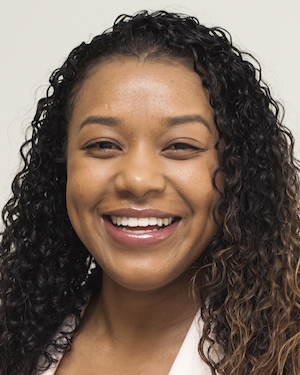
Latino College Expo ⟩
November 15, 2018, by Serena
What a great turn out at this year’s 5th Annual Latino College Expo™!
What is the Latino College Expo?
Mostly comprised of high school and middle school Latino students, the event had recruiters from higher education (like me) and positive post-secondary pursuits (like recruiters from Disney Animation). The event had resources on grants, loans, and the Dream Act; additionally, information on internships and career opportunities were given.
What did I do at the event?
While raising awareness about USC’s OT program with Diego Lopez, an occupational therapy doctorate (OTD) student, we spoke to over 300 high school students and even middle school students, (yes 8th graders :0) about OT. I wish I would have known about OT when I was in 8th grade! It was such an incredible sight to see so many young students not knowing what OT was but then realizing that their unique interests could be found in OT. For example, there were students interested in design and mechanical engineering and they realized that they could become an OT focusing on helping individuals live a more meaningful life by designing more functional prosthetics. Other students with a desire to pursue a major in criminology came to learn about OT’s role in forensic mental health and OT’s ability to work in the criminal justice system.
Given the age of the crowd, the middle and high schoolers were mostly interested in USC’s accelerated Bachelor’s to Master’s in Occupational Therapy program. They were amazed and thrilled to learn that they could receive their Master’s in just 5 years and their doctorate in occupational therapy in just one subsequent year!
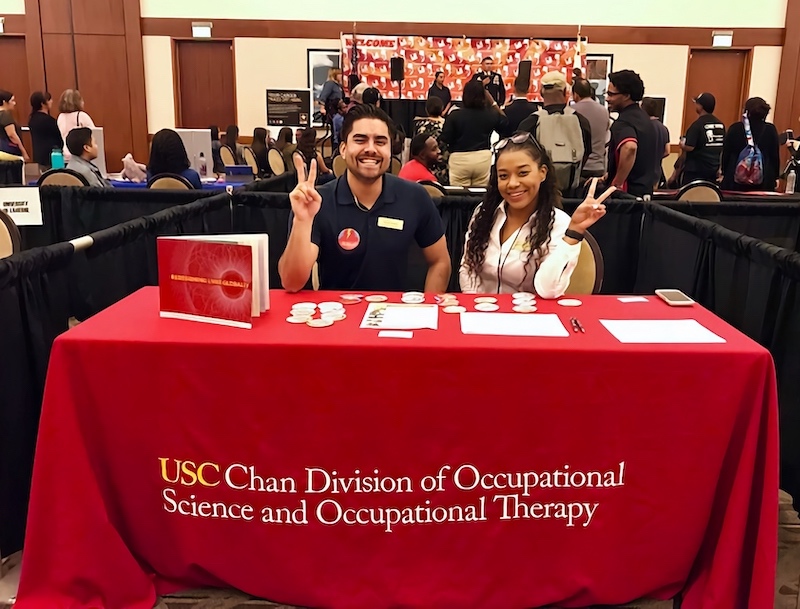
OTD student, Diego Lopez, and I educating high school and middle school students about USC occupational therapy programs at the 5th Annual Latino College Expo event in Pomona, California.
The highlight of the event!
One of the highlights of the event is when the host of the event came up to the USC Occupational Therapy booth and let me have the microphone! I was in utter disbelief. My face completely lit up! I was so surprised since I was the only booth she had given the ability to speak on the microphone in front of the ENTIRE crowd! You know I took full advantage of the opportunity! I politely yet firmly grabbed the microphone and proudly stated my OT elevator pitch with a huge smile on my face. I mean, the opportunity to spread awareness about the best profession in the world 😉 to over 600 people does not happen that often.
In the Future . . .
I am most definitely looking forward to attending the 6th Annual Latino College Expo next year. Maybe next time they will let me go on the main stage with the microphone!
20th Annual Black College Expo
Stay tuned for a post about the 20th Annual Black College Expo, which will take place at the LA Convention Center on February 2nd. If you are a current USC OT student or alumni of the program, please message me if you would like to attend the event and help raise awareness about USC’s OT program!
⋯
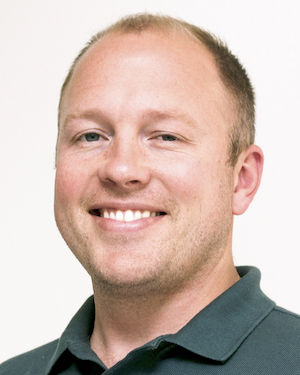
Having a Baby While in Grad School ⟩
November 14, 2018, by Evan
Life Hacks School/Life Balance
The biggest thing going on in my life at the moment is that my wife and I are expecting a baby girl this January. It will be our second (we also have a 2.5-year-old boy) and we are grateful that all signs so far point toward a healthy pregnancy. When sharing this news with my student colleagues, I get mixed responses. Of course, everyone is excited first and foremost. But then for some the excitement melts away into a touch of concern. One classmate last week even went so far to ask, “How are you going to manage it?”
My response is always the same: “Having babies in graduate school doesn’t have to be more difficult than having a baby with a full-time job!” In fact, in some ways it may even be easier. Let me explain:
USC CHAN OFFERS AN INCREDIBLY SUPPORTIVE ENVIRONMENT — most of my teachers have families of their own and have been very supportive about my journey into the occupational role of being a parent. Even though I am a male and not physically carrying a child, they recognize the importance of my presence and involvement during the critical moments of pregnancy, the birthing process, and early childhood. It’s wonderful to know that I will always be able to be there for my family without incurring unreasonable academic penalty.
THERE ARE OPTIONS — while I am electing not to take time off school, it was made clear to me from the beginning that it was an option. Students in the past have chosen to take a semester off class, or delayed a level II fieldwork, and then were able to pick back up right where they left off several months down the road. This is also true with regard to my student job. I am so grateful that my supervisor has given me some flexibility on hours during the month of birth.
BALANCE CAN BE ACHIEVED — of course grad school is academically rigorous, but I honestly find my live-work balance to be healthier now than it was during the years working a full-time job in the film business. Most days I get home between 5-6pm and have the opportunity to eat dinner, give baths, and put my son to bed. This simply would not have been possible in my old job. People always ask when I have time for schoolwork — let me tell you there’s plenty of time after bedtime for homework, especially when you can’t really leave the house!
So for me, having a baby in grad school is doable, and even preferable to trying to manage it while working full-time at my previous job. If anyone out there is hesitant about OT school because they are ready to start a family, I’d encourage them to not feel held back by those fears. Rest assured those feelings are normal — I had them too — but I’m here to tell you it’s possible to earn a master’s degree with a young family. (And even have fun in the process!)
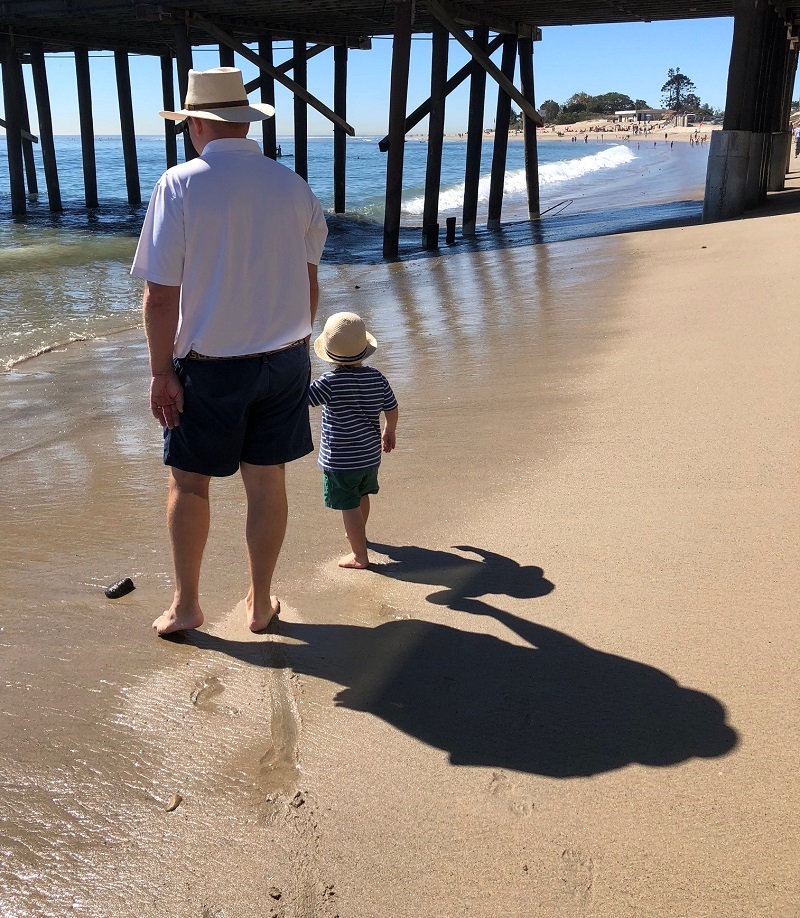
⋯

Infusing Yoga into Fieldwork ⟩
November 12, 2018, by Serena
I am completing my Level I Fieldwork and Jennifer is completing her Level II Fieldwork at the USC Kortschak Center for Learning and Creativity (KCLC) under the mentorship of a previous student ambassador, Dr. Rashelle Nagata. As mentioned in my previous post, the USC KCLC is an academic support center that addresses challenges related to academic performance such as time management techniques, procrastination, self-care strategies, and stress management skills.
Dr. Nagata is our wonderful Fieldwork Educator (FE). A FE, formerly known as a Clinical Instructor (CI), is typically an occupational therapist who mentors and supervises you during your FW experience. In the beginning of our FW, Jennifer and I worked together to build an occupational therapy informed yoga class that incorporated meditation, mindfulness, and gentle yoga stretches to provide a greater awareness of useful calming and alerting strategies that can be easily incorporated throughout the day.
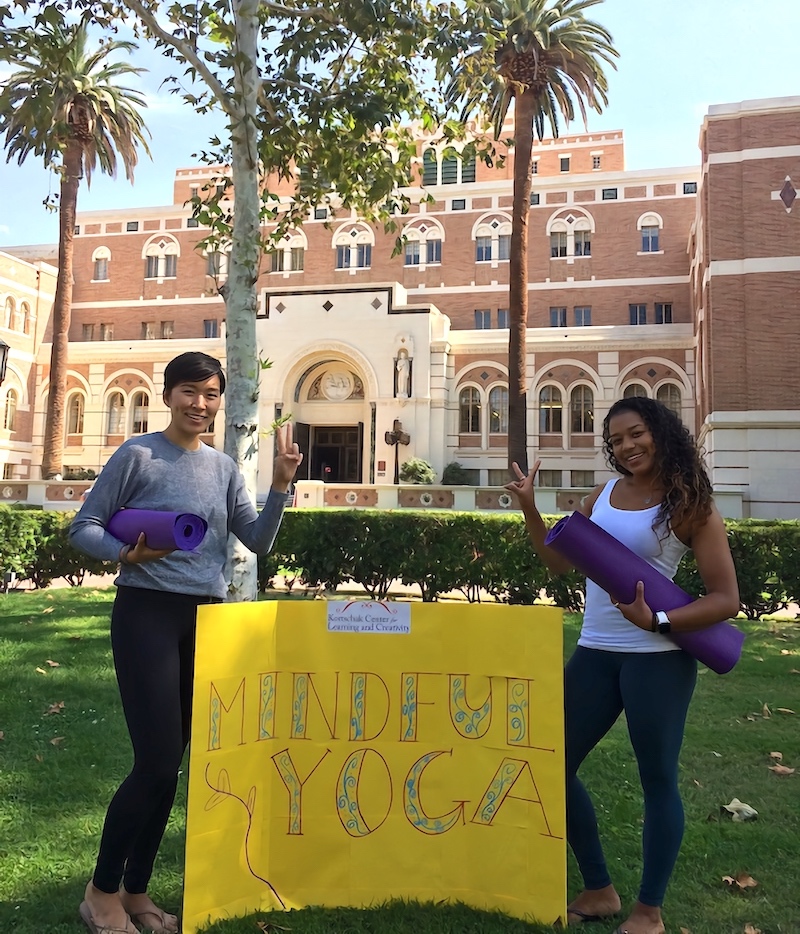
The yoga sessions, which are trauma informed, first begin with a mindful breathing activity, then leads into a guided meditation, and ends with gentle yoga stretches and poses. Throughout the session, aromatherapy and bells or Tibetan sound bowls are incorporated during session to bring greater awareness to the power of senses impacting a calm and alerting state. For example, we pass around lavender in the beginning to elicit a more serene vibe. Towards the end of the session, peppermint oil is offered to those wishing to return to an environment that requires a more alert state of being. We end with the sound of bells or Tibetan bowls, which have healing benefits such as decreasing stress and anxiety.
Namaste.
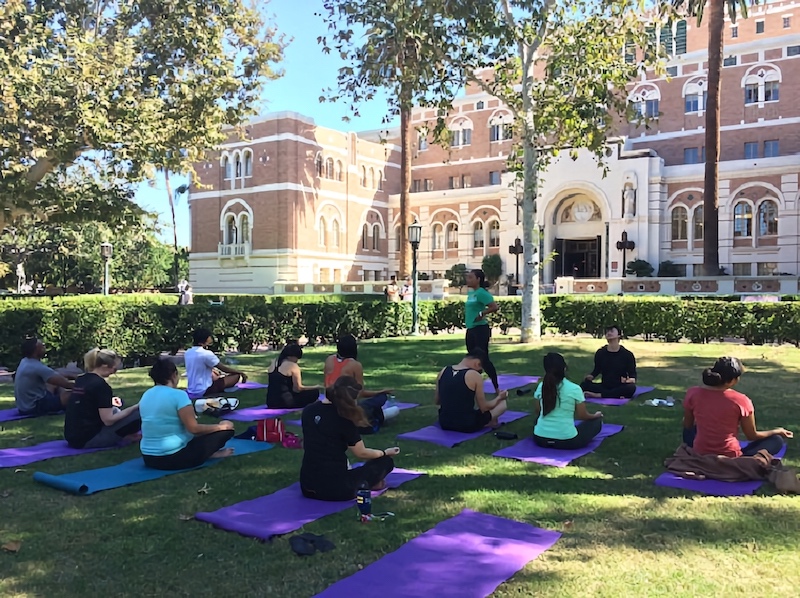
The yoga group comprised of undergraduate, graduate, staff, and faculty members performing gentle yoga stretches in front of Doheny Library on a beautiful sunny Southern California day!
⋯





